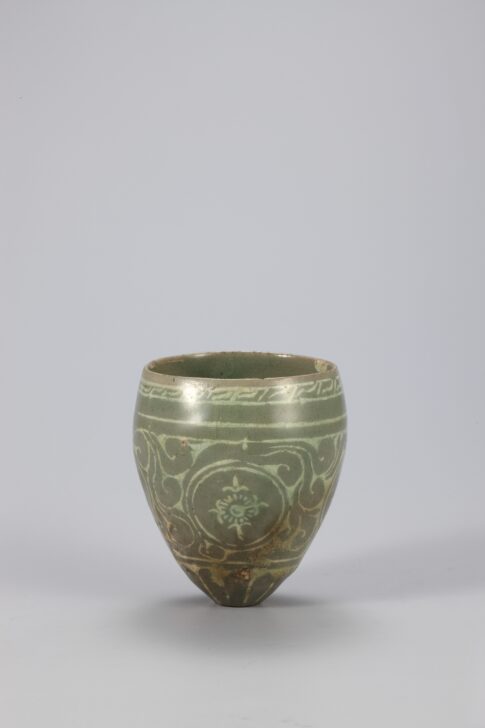Stirrup cup with inlaid sgraffito chrysanthemum and scroll designs
Korean

Description
Copies and Invention in East Asia (August 17, 2019 - January 5, 2020)
The elegant celadon ware produced during the Goryeo period (918–1392) was considered the height of Korean culture in early twentieth century Japan. Soon after Japan colonized Korea in 1910, old kiln sites in the southwest part of the peninsula were excavated by Japanese archeologists. The celadons they unearthed were highly sought after by Japanese connoisseurs and collectors, fetching high prices at auctions. In response to this new market, many copies of Goryeo-type celadons were produced. The Sanwa Goryeo Celadon Ware company was established in Jinnampo (in present-day North Korea) by Japanese businessman Tomita Gisaku (1858–1930) with partial funding from the Japanese colonial government. Tomita invited Japanese potters from Arita, the center of porcelain production in Kyushu, to research and revive the celadon tradition. Their high-quality Goryeo-type celadons came to symbolize the merging of Korean and Japanese culture—the mantra of Japan as it expanded its territories into Asia. This ewer, probably a later piece, faithfully copies the intricate inlay technique of the original celadon, but aspects of the design, such as the robust handle and spout, have been adjusted to modern convenience.
March 28, 2009
This small wine cup was designed to fit perfectly in the hand. Cone-shaped cups were made in unglazed stoneware in the Unified Silla period and came back into vogue during the late Goryeo period under the influence of Yuan dynasty China. The shape was derived from the horn cups that the nomadic Mongol rulers of the Yuan dynasty (1279–1368) used for drinking while on horseback. A cup of this shape was excavated from the village of Yucheon in Buan, North Jeolla province, which once housed royal Goryeo kilns. This vessel shape is rare, with only about a half dozen known in Western collections.
(Label for UMMA Korean Gallery Opening Rotation, March 2009)
Subject Matter:
Stirrup cup with chrysanthemum designs.
Physical Description:
Earthenware stirrup cup with sgraffito design and celadon glaze. A chrysanthemum blossom decorates the tapered base of the cup, and widens into a large middle register with four stylized chrysanthemum medallions. The cup curves back inward toward the rim of the cup, decorated with a fret pattern just below.
This is a conical stirrup cup designed to be inserted into a cup holder. It is a fine piece of celadon with the sudtle beauty of white inlaid decorations in match with the blue-gray body. Its entire outer wall is decorated with inlaid motifs of fret, chrysanthemums, scrolls and lotus petals.
[Korean Collection, University of Michigan Museum of Art (2014) p. 128]
Usage Rights:
If you are interested in using an image for a publication, please visit https://umma.umich.edu/request-image/ for more information and to fill out the online Image Rights and Reproductions Request Form.